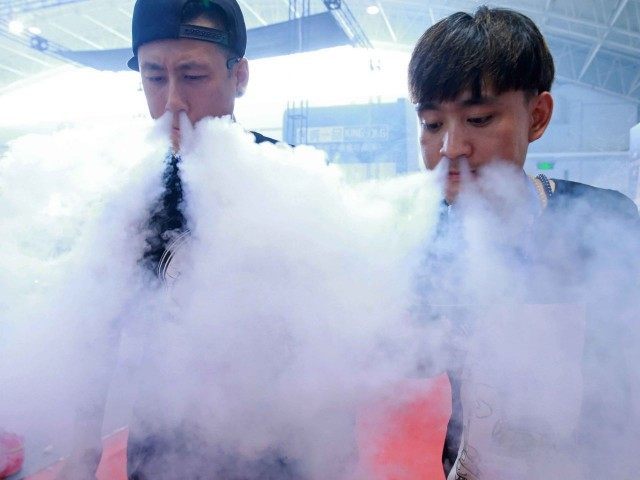Looking to form class action lawsuits under California’s Proposition 65, nominal plaintiff Jerod Harris filed a federal complaint against R.J. Reynolds Vapor Co. claiming he didn’t know vaping uses nicotine.
Battery-powered vaporizers, known as e-cigs, simulate the feeling of smoking without tobacco combustion. Their use is commonly referred to as “vaping.”
Since its patenting by a Chinese pharmacist named Hon Lik, the use of a high-frequency piezoelectric ultrasound-emitting element combined with a pressurized jet of liquid containing nicotine has ignited a major boom. Vaping’s inventor developed the device to end lung cancer, emphysema and other deadly side effects of traditional smoking.
The boom really took off after a federal court in 2010 overturned a U.S. Food and Drug Administration (FDA) 2009 decision to regulate e-cigs like cigarettes. Since 2013, the number of vape stores has jumped from 3,500 to 35,000. RJR’s ‘Vuse’’ is now America’s most popular e-cigarette, with about $400 million in sales.
Cigarettes were once a spectacularly good business for retailers, such as convenience stores. According to the Association for Convenience and Petroleum Retailing, cigarettes accounted for nearly 36 percent of the sales revenue in convenience stores in their peak year of 2009. Average cigarette revenue per store was $576,354 with an 18 percent gross profit of $89,923. In the last 6 years, cigarette smoking has declined.
But that is chump change compared to profits in the vape business. Most accessories and vape products have a markup of between 200 and 400 percent. Some electronic pens cost $250. With total sales up from $1 billion in 2013 to $2.5 billion in 2014, some stores are bringing in $1.3 million a year.
Doctors state that vaporizers are safer than 7,000 chemicals in cigarette smoking, but there haven’t been any long-term studies to suggest what years of vaping will do to a body. The good news is that cigarette smoking has fallen by 18 percent, according to the Centers for Disease Control and Prevention (CDC). But e-cigs and vape pipes usually use-candy type flavorings, which are extremely attractive to teenagers, to deliver nicotine.
The combination of a booming industry, lack of information, concerns about long-term effects on youth,b and Reynolds Vapor Co. as a deep pocket was bound to cause enterprising mass tort lawyers to sue under California’s Safe Drinking Water and Toxic Enforcement Act of 1986, known as Prop 65.
The initiative was supposedly intended by its authors to protect California citizens and the State’s drinking water sources from chemicals known to cause cancer, birth defects or other reproductive harm, and by requiring companies to disclose to citizens what the effect of the exposures to such chemicals would be. But it was funded by mass tort lawyers.
PepsiCo was forced into a big settlement on September 15 under Prop 65 because of its use of the scary sounding 4-Methylimidazole for its distinct caramel coloring. Despite the U.S. Food and Drug Administration and its Canadian and the European Union counterparts saying the chemical poses no risk to human health for ingestion of up to 1,000 cans of soda a day, California listed 4-mei as a “known carcinogen” under its chemical labeling law.
Pepsi agreed to pay $385,000 to settle claims in Center for Environmental. Health v. Pepsi Beverages Co., No. 14711020, admitting that its products contain levels of 4-methylimidazole (4-MEI) that exceed the limits imposed by the Safe Drinking Water and Toxic Enforcement Act of 1986.
The settlement paves the way for parties to a proposed class action lawsuit alleging similar facts titled, No. 178953 to stay proceedings until December 14, 2015, pending settlement discussions. The monetary numbers in that case are expected to be huge.
The beauty of Prop 65, from a mass tort lawyer’s point of view, is that the law puts the onus on businesses to label their products as carcinogens if rats given very large doses of a chemical develop any cancerous tumors.
Just six days after just days after California’s Health Department on January 28 declared e-cigarettes are a public health threat, the Oakland, CA nonprofit health watchdog Center for Environmental Health (CEH) filed a complaint on February 5, 2015 against 19 companies that sell e-cigarettes and/or e-liquids without consumer warnings, as required under Prop 65. CEH claims that the products expose users to nicotine, a chemical known to pose serious reproductive health hazards, and thus must carry warnings. The named defendants are::
E-liquids
- Ballistic Vape Inc.; Ballistic Vape TruNic USA Liquid Nicotine in Praline Dream
- Steam Distribution; Ballistic Vape TruNic USA Liquid Nicotine in Praline Dream
- Beard Vape Co; Beard Vape Co.Juice No. 5
- Bodyrock Products; Hard Cocktails E-Liquid in Angel’s Share
- The Daily Vapes; The Daily Vapes Juice in Bake Sales
- Exquisite E Liquid; Exquisite E-Liquid in Nature’s Harvest
- Five Pawns; Signature Vapor Liquid Mixology Edition in Perpetual Check
- Joyetech/Shenzhen Joyetech; Joyetech Cigar E-Liquid
- Limitless Trading Co; Drip E-Liquid in Guava Nectar
- Nicopure Labs; EVO E-Liquid Evolved in Maraschino
- Tenacious 7 Vapor; Tenacious 7 E-Juice in Peach Fuzz
- Throttle Vapor; Throttle Vapor E-Juice in Slow Ride
- USVC, Inc.; Organic Premium Vape Juice in Nutty Chocolate
- The Vape Kitchen; Epicurean E-Liquid in Thai Mango Sticky Rice
- Vaporall; E-Liquid in Lusty Lychee
E-cigarettes and/or vaping kits
- PHD Marketing; Xhale X MC Vapor Pen in Green
- S & E Distributor; Tsunami Disposable E-Cigarette
- Smoke Tokes; Green Man CE Series Vaporizer
- Vapor Exotica; V-Exotica Vapor Pen

COMMENTS
Please let us know if you're having issues with commenting.